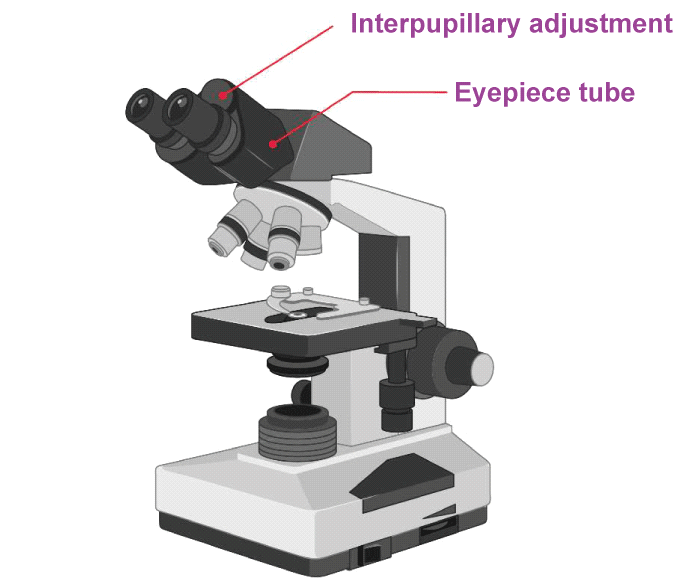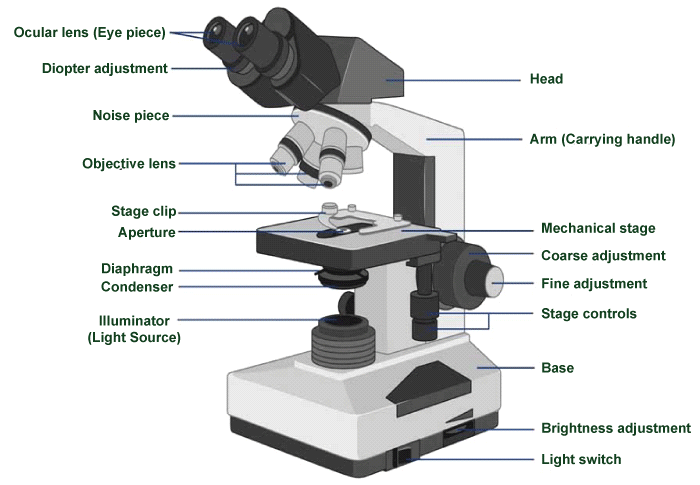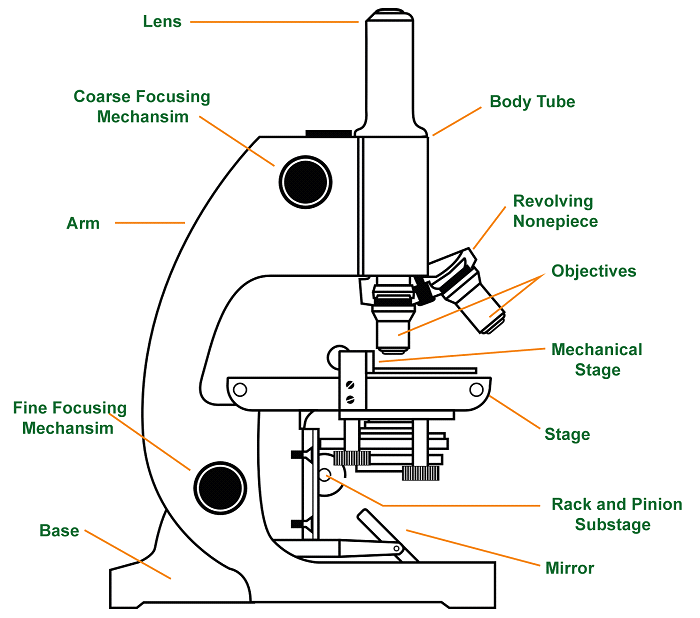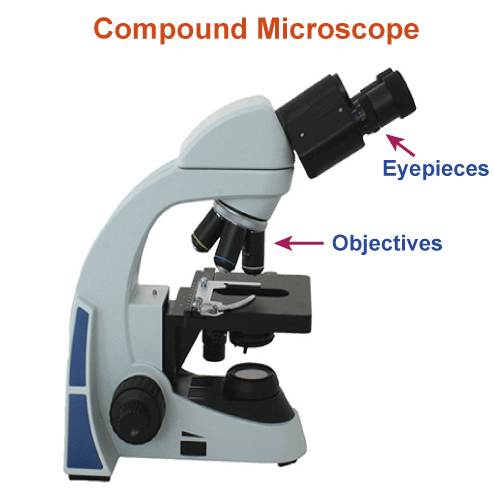Microscope DefinitionA microscope is an instrument that has revolutionized the way we see and understand our world. It is an optical device that mainly creates enlarged images of minor objects, giving us an exceedingly closer view of tiny structures at a scale convenient for identification and analysis. One of the most significant advantages of using a microscope is its ability to magnify microscopic objects that are not visible to the naked eye. With this incredible tool, people can observe various organisms such as cells, bacteria, viruses, fungi, and many others. Moreover, microscopes have helped scientists make ground-breaking discoveries by allowing them to study particles too small to be seen. For example, they have enabled researchers to analyze dust particles and determine their composition accurately. Also, microscopes are essential tools used in various fields like biology, chemistry and physics for research purposes or educational activities. Let us look at important information about the microscope. What do you mean by Microscope?A microscope is a tool which is utilised to see minor objects that may not be observed and seen with the naked eye. The word comes from Greek, meaning "small" and "to see." 
A microscope is a highly valuable scientific instrument that has revolutionized the way we observe and study small objects. It works by magnifying the image of an object, making it appear larger than its actual size. This enlargement enables each person to see objects with the naked eye. Microscopes are tubes with lenses that refract light rays. The simplest microscope is a magnifying glass made from a convex lens, while compound microscopes used in schools and labs have at least two lenses to produce an image. Most can magnify by 10-100 times, but professional ones can go over 1000 times. Parts of Microscope
1) Arm The arm is located at the back and supports the objectives and ocular. It also allows for the carrying or lifting of the device. 2) Base The base is the bottom part of the microscope, which also contains the light source. The back section of the base can be used as a handle to carry the scope. 3) Course Focusing Knob and Fine Focusing Knob The course-focusing knob is utilised to modify the position of objective lenses without hitting the slide while, the fine-focusing knob brings the specimen into ideal focus once it is visible via the course-focusing knob. 4) Illuminator The illuminator is the microscope's light source, which provides light. 5) Objective Lens The numerical aperture or objective lens is the lens, which is very near to the specimen in a compound microscope. 6) Ocular Lens The ocular lens is the lens, which is the nearest or closest lens to the viewer in the compound microscope. 7) Oil Immersion Lens The oil immersion lens is a small objective lens that offers high resolution and magnification at 100x. Various Types of MicroscopesThere are multiple kinds of microscopes, such as those below. 1. Simple Microscope
The first type of microscope ever created is known as a simple microscope. It was invented by Antony van Leeuwenhoek in the 17th century, who combined a convex lens with a holder for specimens to create this groundbreaking tool. The magnifying power of the simple microscope ranges between 200 and 300 times, making it an essential tool in scientific research at that time. Essentially, it was like a magnifying glass but with more precision and accuracy. Today, we can find examples of this kind of instrument in hand lenses and reading lenses. A simple modern-day microscope consists of a double convex lens with a short focal length, which produces an erect image when an object is placed near its principal focal point. This image appears larger than the original object due to the magnification effect produced by the lens. It's important to note that while these images are virtual and cannot be projected onto screens like real images, they have still been instrumental in advancing our understanding of microscopic organisms such as bacteria or viruses. Thanks to Antony van Leeuwenhoek's pioneering work on microscopy technology centuries ago, we continue to make new discoveries about our world today! 2. Compound Microscope
A compound microscope is a highly useful tool for examining small objects that are too tiny to be seen with the naked eye. This type of microscope operates by using two sets of lenses, which work together to produce a 2-dimensional image of the sample being studied. The term "compound" refers to the fact that more than one lens is used in this type of microscope, as opposed to simple microscopes, which only use one. Compound microscopes are just one type of optical microscope, with the other being simple microscopes. While simple microscopes can provide magnification up to 1,000 times, they have low resolution and cannot produce images comparable in quality to those produced by compound microscopes. However, both types allow scientists and students alike to take an up-close look at specimens too small for the naked eye. Typically, specimens viewed through a compound microscope are very small and somewhat transparent like individual cells or microscopic organisms. Because these devices are relatively inexpensive compared to other scientific equipment, they can be found everywhere, from research labs at universities all over the world down to high school biology classrooms where students first learn about cell structure and function. 3. Darkfield MicroscopeA darkfield microscope scatters light to create a white image of transparent or translucent specimens against a black background. This method is useful for observing living cells and small organisms, allowing researchers to see details and structures that may be difficult to observe with other types of microscope. Darkfield microscopes are used in various fields, such as biology, medicine, and materials science, without damaging the samples through invasive techniques. 4. Electron MicroscopeThe electron microscope produces images using electrons instead of light and can enhance the visualization of viruses, proteins, lipids, ribosomes, and small molecules. 5. Fluorescence MicroscopeFluorescence microscopes are a type of microscope that uses ultraviolet light to illuminate specimens. The specimens viewed under these microscopes fluoresce, which means they emit light when exposed to UV radiation. This process is used extensively in biological research and medical diagnosis. 6. Contrast or Phase MicroscopeThe Contrast/Phase Microscope utilizes a unique condenser to examine structures inside cells and takes advantage of different refractive indexes for live organisms. The microscope produced the final image, which is a combination of light and dark. Uses of MicroscopeThe microscope is a crucial instrument in various scientific fields, serving multiple purposes. From traditional medical science to forensics, the uses of microscopes are vast and varied. Microscopes have become indispensable tools for scientists across different disciplines.
ConclusionThe invention of the microscope has been a game-changer in our quest to understand the world around us. Before its advent, we were limited to observing things with our naked eyes, which restricted our knowledge of what existed beyond what was visible. However, with the microscope's discovery, we have gained unprecedented access to a completely new universe that exists at microscopic levels. This incredible tool has allowed us to see and study tiny organisms like bacteria and viruses that were previously invisible to us. Therefore, it is very helpful.
Next TopicNiche Definition
|
 For Videos Join Our Youtube Channel: Join Now
For Videos Join Our Youtube Channel: Join Now
Feedback
- Send your Feedback to [email protected]
Help Others, Please Share










